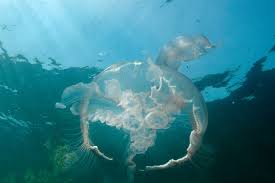Unusually high number of jellyfish arrive in UK seas

London: An unusually high number of jellyfish have arrived in the UK’s seas this summer, experts have said.
Jellyfish blooms arrive for their yearly reproduction cycle by following the current of warm water to the coast. Warm sea surface temperatures, which are exacerbated by global heating, create favourable conditions for jellyfish.
This contributes to a population bloom and a prolonged stay during the summer season, and experts say the conditions are likely to lead to the arrival of new jellyfish species that prefer warmer waters.
With record-high sea surface temperatures in April and May this year, according to the Met Office, a greater number of jellyfish blooms are expected to populate the UK coast.
Jellyfish are a foundational element of the aquatic food web, as they are types of plankton that form the bases of many food chains. Compass jellyfish, identified by dark stripes on their bells and long tentacles which cause a painful sting, are a particular favourite source of food for turtles, said Abigail McQuatters-Gollop, a marine conservation specialist at the University of Plymouth.
A common but spectacular species that has arrived in great numbers in UK waters this summer is the barrel jellyfish, which can grow to a metre in diameter. It has a thick bell with frilly arms. This species has a relatively mild sting and is eaten by humans in some areas of the world, such as parts of Asia.
Other jellyfish species that have been identified this year include moon, lion’s mane, blue and mauve stinger species.
The number of jellyfish sightings recorded by the Marine Conversation Society in 2024 was 1,432, a 32% increase compared with the previous year. McQuatters-Gollop said some evidence suggests that we are “more likely to have more jellyfish blooms because of climate change and the water getting warmer.”
But the jellyfish will not stay for long as they have a short lifespan, with some being born and dying within the same summer.





